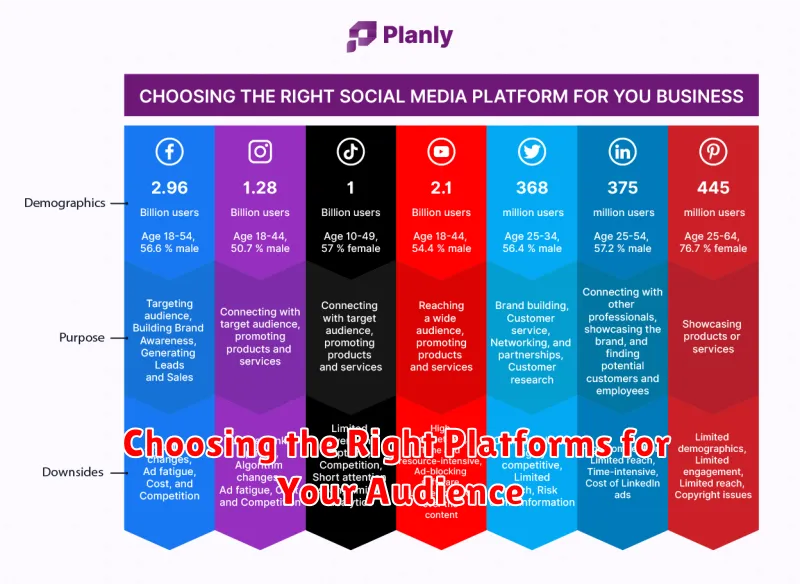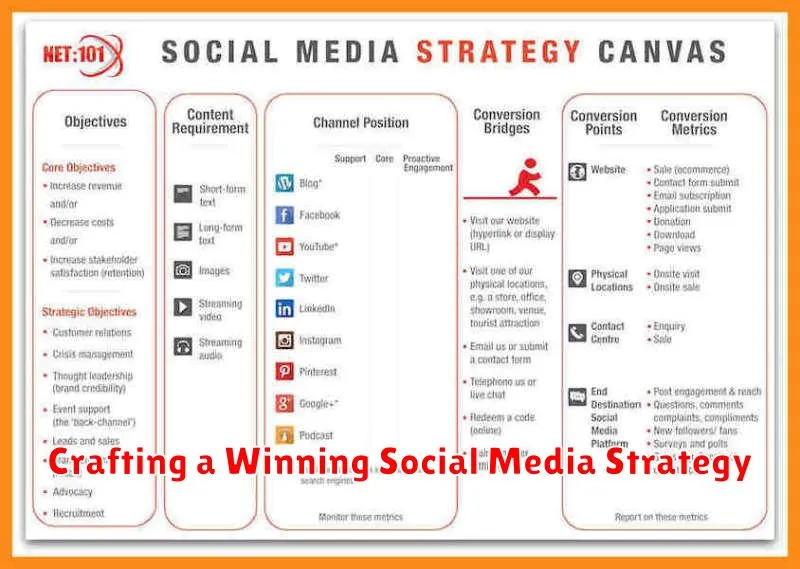In today’s digitally-driven world, a robust social media strategy is no longer a luxury but a necessity for businesses of all sizes. Whether you’re a budding startup or an established enterprise, harnessing the power of social media is paramount to connecting with your target audience, building brand awareness, and ultimately, driving business growth. This article will equip you with the essential knowledge and practical steps to craft a winning social media strategy that delivers measurable results. Learn how to define your target audience, select the right social media platforms, create engaging content, and analyze your performance to optimize your approach. Mastering these key elements will empower you to leverage the full potential of social media and achieve your business objectives.
Developing a successful social media strategy requires careful planning and execution. From setting clear goals and objectives to crafting a compelling brand voice and implementing effective engagement tactics, every step plays a crucial role in achieving desired outcomes. This comprehensive guide will walk you through the process of building a data-driven strategy, enabling you to track your progress, measure your return on investment (ROI), and adapt your approach based on real-time insights. By the end of this article, you’ll be well-equipped to create a winning social media strategy that elevates your brand presence, fosters meaningful connections with your audience, and drives significant business impact.
Why Every Brand Needs a Social Media Strategy
In today’s digital age, a robust social media presence is no longer optional but essential for brand success. A well-defined social media strategy provides a roadmap for connecting with your target audience, building brand awareness, and ultimately driving business growth.
Without a strategy, social media efforts become fragmented and ineffective. A strategic approach ensures that every post, every interaction, and every campaign contributes to overarching business objectives. This focused approach maximizes resource allocation and return on investment.
Increased visibility is a key benefit of a strong social media strategy. Platforms like Instagram, Facebook, and X (formerly Twitter) provide access to billions of potential customers. A strategic approach allows brands to target specific demographics and interests, ensuring messages reach the right audience.
Furthermore, social media fosters two-way communication with customers. This direct engagement builds brand loyalty and provides valuable insights into customer preferences and needs. These insights can inform product development, marketing campaigns, and overall business strategy.
Finally, a social media strategy is dynamic. It allows brands to adapt to evolving trends, platform algorithms, and audience behavior. This adaptability ensures sustained engagement and continued growth in the ever-changing digital landscape.
Setting SMART Goals for Your Campaigns
Establishing clear, measurable objectives is crucial for social media success. This involves setting SMART goals – goals that are Specific, Measurable, Achievable, Relevant, and Time-bound. This framework provides a roadmap for your campaigns and allows you to track progress effectively.
A specific goal clearly defines what you want to accomplish. Instead of aiming to “increase brand awareness,” a specific goal might be to “increase website traffic from Instagram by 15%.” Measurable goals allow you to quantify your progress. Choose metrics that directly reflect your objectives, such as website clicks, engagement rate, or lead generation. Achievable goals are realistic and attainable given your resources and current performance.
Relevant goals align with your overall business objectives. Ensure your social media campaigns contribute to broader marketing and business strategies. Finally, time-bound goals establish a deadline for achieving your objectives. This creates a sense of urgency and helps maintain focus. By adhering to these principles, you can create effective campaigns that drive meaningful results.
Choosing the Right Platforms for Your Audience

Identifying the right social media platforms is crucial for a successful strategy. It’s not about being everywhere, it’s about being where your target audience is. Different demographics favor different platforms. For example, a younger audience might be predominantly on TikTok and Instagram, while professionals may be more active on LinkedIn.
Research your audience’s online behavior. Where do they spend their time? What kind of content do they engage with? Analyzing these factors will help you prioritize which platforms deserve your focus and resources.
Consider your business objectives. Are you focused on brand awareness, driving sales, or customer service? Each platform offers unique features and functionalities that cater to different goals. For instance, Instagram is highly visual and suitable for showcasing products, while Twitter excels at real-time engagement and news dissemination.
Evaluate platform demographics. Most platforms provide detailed insights into their user base. This data can help you confirm whether your target audience aligns with the platform’s demographics. By understanding your audience and platform characteristics, you can effectively tailor your content and messaging to resonate with the right people.
Creating a Consistent Posting Schedule
A consistent posting schedule is a cornerstone of a successful social media strategy. It keeps your audience engaged and helps build a predictable online presence. Without consistency, your content may get lost in the constant stream of information, diminishing its impact and reach.
Finding the optimal posting frequency depends on several factors, including your target audience, the social media platform, and the resources you can dedicate to content creation. Experiment to determine what works best for you. Start with a realistic schedule and gradually increase frequency as you gain experience and resources.
Using a social media management tool can be invaluable for scheduling posts in advance. This allows you to maintain a consistent presence even when you’re busy with other tasks. These tools often offer analytics to track post performance and identify the best times to post for maximum engagement.
Remember, consistency doesn’t just mean posting frequently; it also means maintaining a regular pattern. Whether you post daily, several times a week, or weekly, stick to a predictable rhythm to keep your audience engaged and expecting your content.
Balancing Promotional and Value-Driven Content
A successful social media strategy hinges on finding the right balance between promotional content and value-driven content. Overly promotional posts can alienate your audience, while solely focusing on value can hinder sales and brand growth. The key is to provide a mix that engages your followers and subtly promotes your brand.
Value-driven content should be your primary focus. This includes informative posts, entertaining content, and resources that genuinely benefit your target audience. Think educational videos, insightful articles, engaging polls, or behind-the-scenes glimpses. This builds trust and establishes your brand as an authority.
Promotional content is essential for driving conversions. This could be showcasing new products, highlighting special offers, or running contests. Ensure your promotional posts are strategically woven into your content calendar, avoiding an overwhelming sales pitch. Focus on the value proposition and how your product or service solves a problem for your audience.
A common approach is the 80/20 rule: 80% value-driven content and 20% promotional. This provides a framework for maintaining audience engagement while still achieving business objectives. However, the ideal ratio may vary based on your industry and target audience, requiring careful monitoring and adjustment.
Using Hashtags Effectively
Hashtags are essential for increasing the discoverability of your social media content. They categorize your posts, making them easier to find by users interested in specific topics. Relevance is key. Use hashtags that are directly related to your content. Avoid generic or overly broad hashtags as they dilute your reach.
Research popular and trending hashtags within your niche. Tools like hashtag generators can help identify relevant options. However, prioritize quality over quantity. A few well-chosen hashtags are more effective than a long, irrelevant list. Analyze the performance of your hashtags to understand which ones are driving the most engagement.
Brand consistency is also important. Consider creating a branded hashtag unique to your business. This promotes brand recognition and encourages user-generated content. Integrate hashtags seamlessly within your captions. Avoid stuffing hashtags awkwardly at the end of a post. Instead, weave them naturally into your sentences.
Different platforms have different hashtag best practices. For example, two to three hashtags is generally recommended for Twitter, while Instagram allows up to thirty. Adapt your hashtag strategy accordingly for each platform to optimize reach and engagement.
Social Listening and Engagement
Social listening is the process of monitoring social media channels for mentions of your brand, competitors, industry, and related keywords. This crucial step allows you to understand public perception, identify potential crises, and discover opportunities for engagement.
Effective social listening involves more than simply tracking mentions. It requires analyzing the sentiment behind those mentions to gauge overall brand health and customer satisfaction. Are people praising your products or complaining about customer service? Understanding these nuances informs strategic decision-making.
Engagement is the active participation with your audience on social media. This includes responding to comments and messages, participating in relevant conversations, and sharing valuable content. Active engagement fosters a sense of community and builds stronger relationships with your followers.
Engaging with your audience necessitates a proactive approach. Don’t just wait for users to reach out to you; actively seek out opportunities to participate in relevant discussions and provide helpful information. This demonstrates that you value your audience and are invested in their needs.
Working with Influencers
Influencer marketing is a powerful tool within a comprehensive social media strategy. By partnering with individuals who have a dedicated and engaged following, brands can expand their reach and build credibility. Selecting the right influencers is crucial. Look for those whose audience aligns with your target demographic and whose values resonate with your brand.
Establishing clear campaign goals is essential for a successful influencer collaboration. Whether your objective is to increase brand awareness, drive sales, or generate leads, ensure these goals are communicated clearly to the influencer. Transparency and authenticity are paramount. Disclose the partnership to audiences and encourage influencers to create content that feels genuine and integrates naturally with their existing style.
Measuring campaign performance is key to understanding the impact of influencer marketing. Track metrics such as reach, engagement, website traffic, and conversions to evaluate the effectiveness of the collaboration and inform future campaigns. A well-structured influencer marketing campaign can significantly amplify your social media efforts.
Analytics: What to Track
Tracking the right metrics is crucial for understanding the effectiveness of your social media strategy. It allows you to measure progress, identify areas for improvement, and ultimately, achieve your desired outcomes.
Focus on key performance indicators (KPIs) relevant to your goals. If your objective is brand awareness, track metrics like reach, impressions, and share of voice. These indicate how far and wide your content is spreading.
For engagement-focused goals, monitor metrics such as likes, comments, shares, and click-through rates. These provide insight into how your audience is interacting with your content.
If your goal is driving conversions, pay close attention to website clicks, lead generation, and sales stemming from social media activity. These demonstrate the direct impact of your strategy on business outcomes.
Regularly analyze these metrics to identify trends and patterns. This will inform data-driven decisions and allow you to refine your strategy for optimal performance.
Refining Strategy Based on Results
A successful social media strategy isn’t static. It requires continuous monitoring and refinement based on performance data. Analyzing results is crucial for understanding what’s working and what needs adjustment.
Key performance indicators (KPIs) provide quantifiable metrics to track progress towards your goals. These might include metrics like engagement rate, reach, website traffic, and conversions. Regularly reviewing these KPIs allows you to identify trends and make informed decisions.
Use analytics tools provided by each social media platform to gather data. These dashboards often provide insights into audience demographics, post performance, and overall campaign effectiveness. Look for patterns in your data. Which posts generated the most engagement? What time of day did they perform best? Understanding these nuances can significantly improve future content strategy.
Don’t be afraid to experiment. Based on your data, test different content formats, posting schedules, and targeting options. A/B testing can be particularly useful for comparing the effectiveness of different approaches. Continuously adapting your strategy based on data analysis is essential for maximizing your social media ROI.

